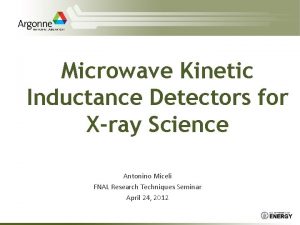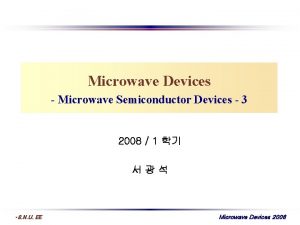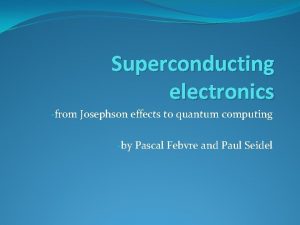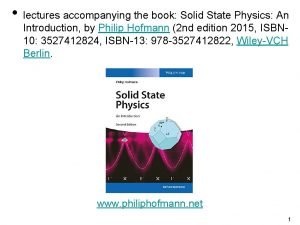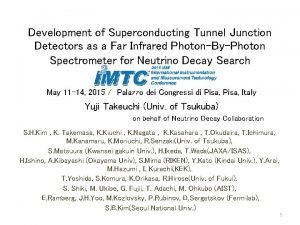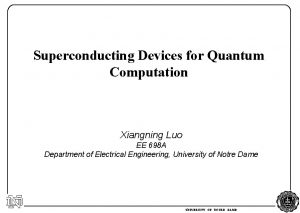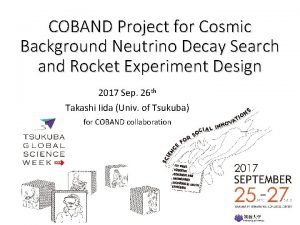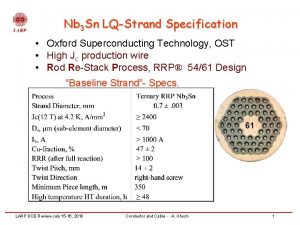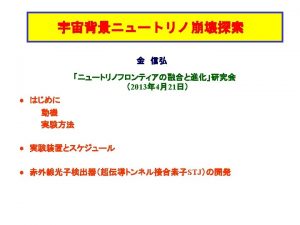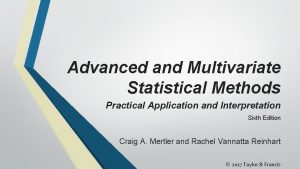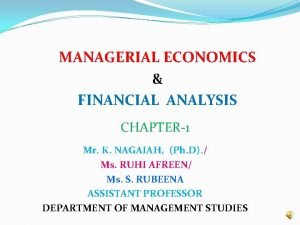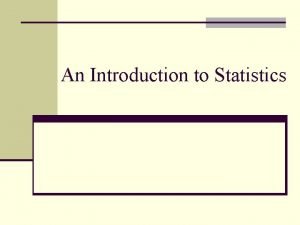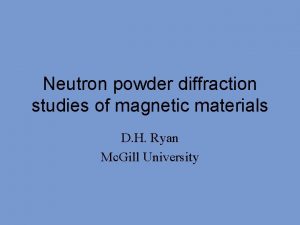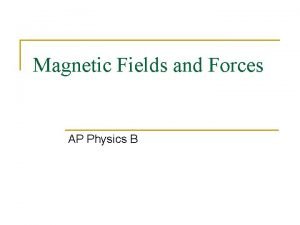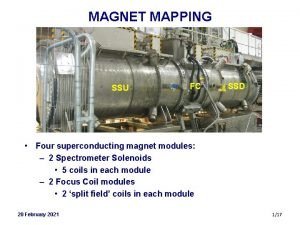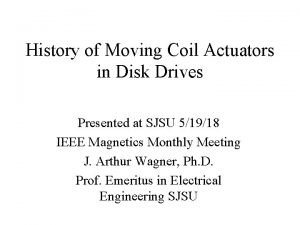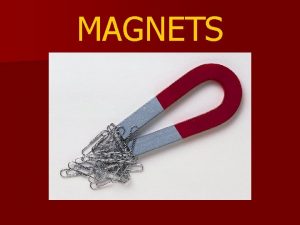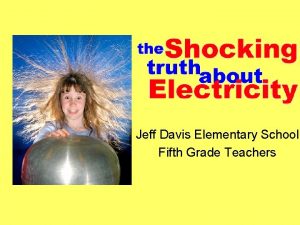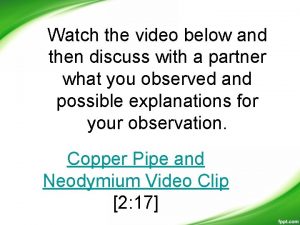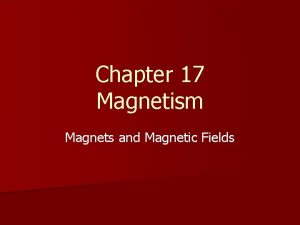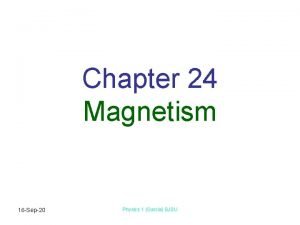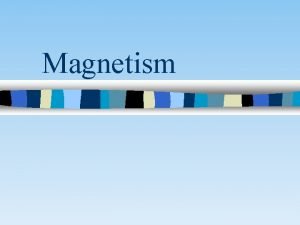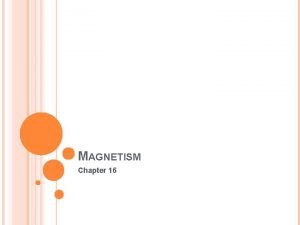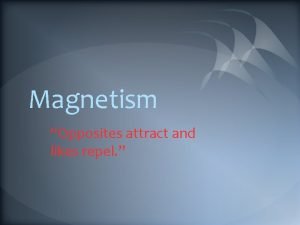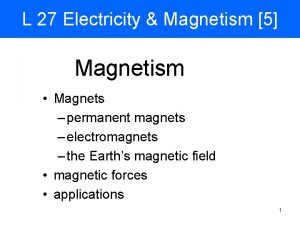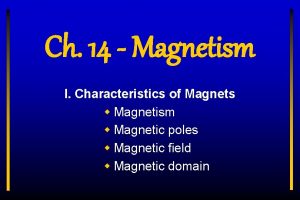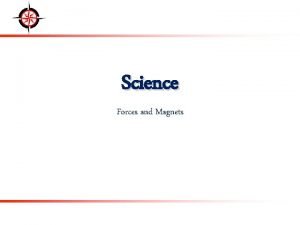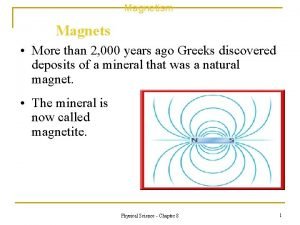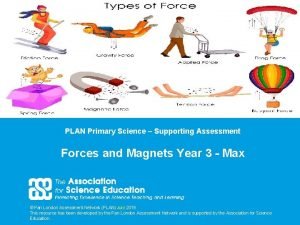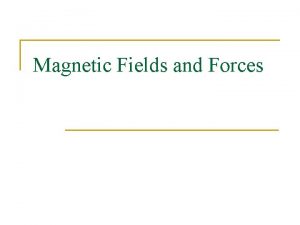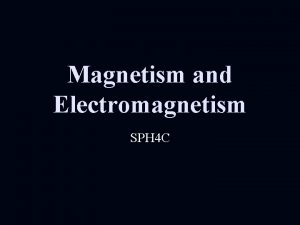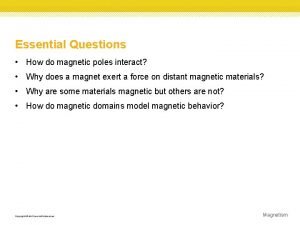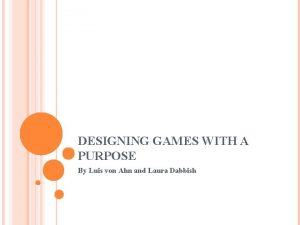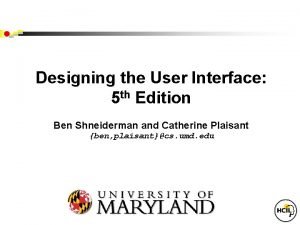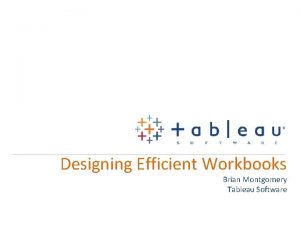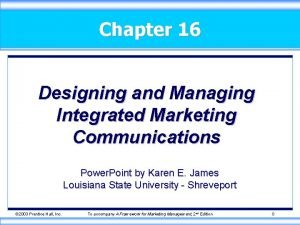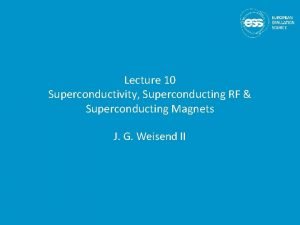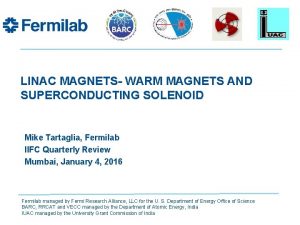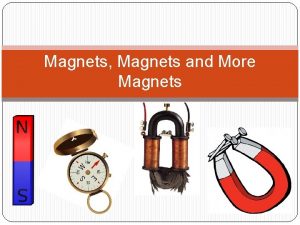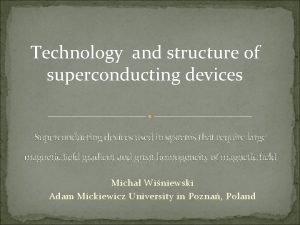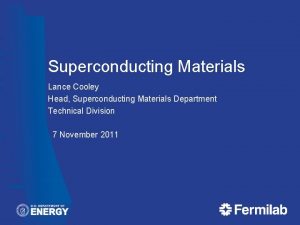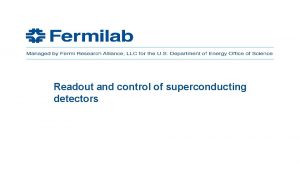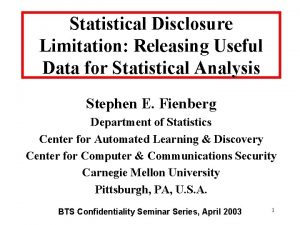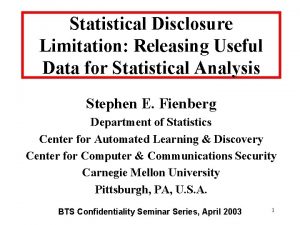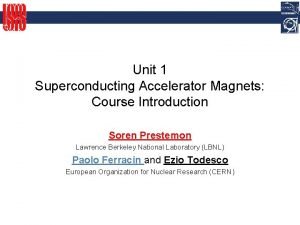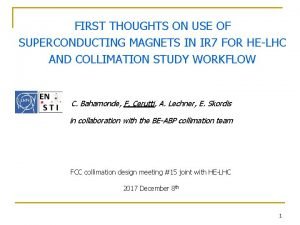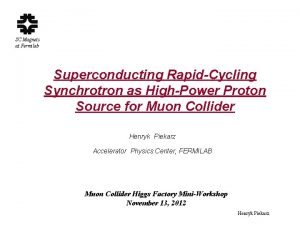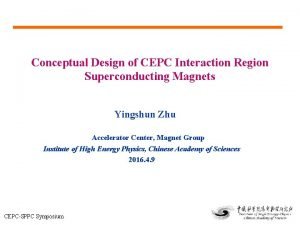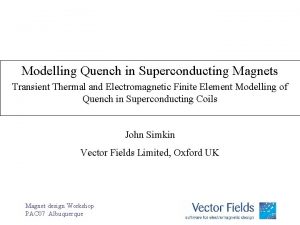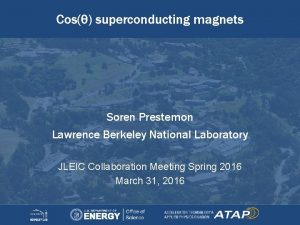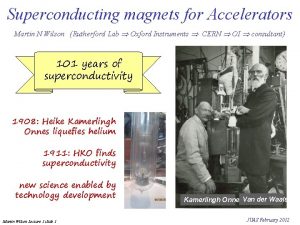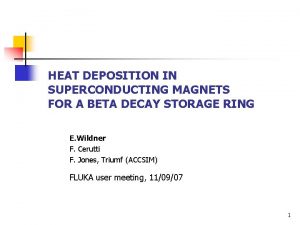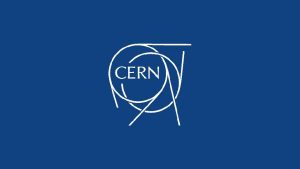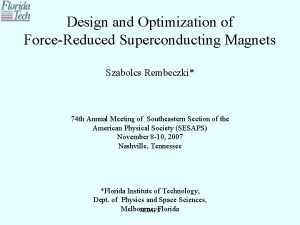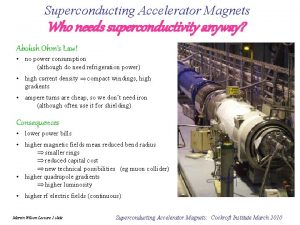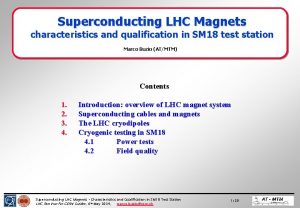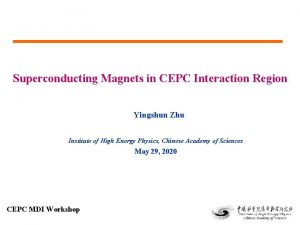Useful Statistical Methods in Designing Superconducting Magnets V








![TOWARDS PROBABILITY DISTRIBUTIONS When we divide by modulus we obtain numbers between [0, 1] TOWARDS PROBABILITY DISTRIBUTIONS When we divide by modulus we obtain numbers between [0, 1]](https://slidetodoc.com/presentation_image/0056b4bacd0d0fe14cd9b18ea5b3aaea/image-9.jpg)































































- Slides: 72

Useful Statistical Methods in Designing Superconducting Magnets V. Calvelli 10/01/2020

SUMMARY Useful Statistical Methods in Designing Superconducting Magnets Page 2

Random Numbers, Probability and Elements of Inferential Statistics

HOW TO GENERATE RANDOM NUMBERS Hardware random number generator (HRNG) Use of physical phenomena to generate numbers by chance Pseudo-random number generator (PRNG) Use of mathematic formules to generate « looklike » random numbers Used in simulations Ex: • Thermal noise • Cosmic background radiation • Electro-magnetic noise These are natural sources of random numbers Generally used to assess the noise in a measure Useful Statistical Methods in Designing Superconducting Magnets Page 4

PSEUDO-RANDOM NUMBER GENERATORS H. Press et all. (1992) Useful Statistical Methods in Designing Superconducting Magnets Page 5

THE MINIMAL STANDARD GENERATOR: HOW IT WORKS Useful Statistical Methods in Designing Superconducting Magnets Page 6

THE MINIMAL STANDARD GENERATOR: HOW IT WORKS Useful Statistical Methods in Designing Superconducting Magnets Page 7

BEST TO USE FOR STANDARD APPLICATIONS Matsumoto, M. (1998) Useful Statistical Methods in Designing Superconducting Magnets Page 8
![TOWARDS PROBABILITY DISTRIBUTIONS When we divide by modulus we obtain numbers between 0 1 TOWARDS PROBABILITY DISTRIBUTIONS When we divide by modulus we obtain numbers between [0, 1]](https://slidetodoc.com/presentation_image/0056b4bacd0d0fe14cd9b18ea5b3aaea/image-9.jpg)
TOWARDS PROBABILITY DISTRIBUTIONS When we divide by modulus we obtain numbers between [0, 1] Useful Statistical Methods in Designing Superconducting Magnets Page 9

RANDOM NUMBERS AND PROBABILITY: THE PROBABILITY DENSITY FUNCTION How to rely random numbers to probability? Useful Statistical Methods in Designing Superconducting Magnets Page 10

RANDOM NUMBERS AND PROBABILITY: THE CUMULATIVE PROBABILITY DENSITY FUNCTION Useful Statistical Methods in Designing Superconducting Magnets Page 11

RANDOM NUMBERS AND PROBABILITY: THE TRANSFORMATION METHOD How to simulate a random probability distribution according to a given probability density function? Useful Statistical Methods in Designing Superconducting Magnets Page 12

PROBABILITY / DISTRIBUTIONS / FUNCTIONS… A PROBLEM OF VOCABULARY ? NOT ONLY Distribution of probability continuous variable discrete variable Useful Statistical Methods in Designing Superconducting Magnets Page 13

A PROBLEM OF EPISTEMOLOGY In a « real » experiment : A) Output of the experiment = raw data (sample) We fit the representation of the data, not the data C) Probability density function PDF = fit histogram Problem: Depends on how good is your fit bin Useful Statistical Methods in Designing Superconducting Magnets Page 14

EPISTEMOLOGY OF A FIT : A CONCEPTUAL MAP When we fit a series of data, we have 3 different objects: FUNCTION ROLE A Data The real world The object B Representation How we see it The subject C Fit Function Logic operation: How we describe it The language Useful Statistical Methods in Designing Superconducting Magnets Page 15

EPISTEMOLOGY OF A FIT 7. 0 E+07 6. 0 E+07 5. 0 E+07 Y Y 4. 0 E+07 3. 0 E+07 2. 0 E+07 1. 0 E+07 0. 0 E+00 0 5 10 15 20 X Useful Statistical Methods in Designing Superconducting Magnets X Page 16

EPISTEMOLOGY OF A FIT Same data Different fit Different representation Bad fit How can we evaluate if a fit is good or not? Useful Statistical Methods in Designing Superconducting Magnets Good fit Inferential statistic Page 17

RANDOM NUMBERS AND PROBABILITY: A CRITICAL ANALYSIS USING INFERENTIAL STATISTIC Result for 1000 random numbers: Useful Statistical Methods in Designing Superconducting Magnets Page 18

TEST TO EVALUATE IF THE DISTRIBUTION FITS A PDF Useful Statistical Methods in Designing Superconducting Magnets Page 19

TEST TO EVALUATE IF A PDF FITS A DISTRIBUTION 14 bins 3 fit parameters Useful Statistical Methods in Designing Superconducting Magnets Page 20

RANDOM NUMBERS AND PROBABILITY: A CRITICAL ANALYSIS Let’s do it again with 10000 random number 25 bins 3 fit parameters Useful Statistical Methods in Designing Superconducting Magnets Page 21

RANDOM NUMBERS AND PROBABILITY: THE BINNING CRITERIA How to choose the correct representation? (The Rebinning Problem) Useful Statistical Methods in Designing Superconducting Magnets Page 22

RANDOM NUMBERS AND PROBABILITY: A CRITICAL ANALYSIS What to use to check everything without driving mad (freeware)? What CERN uses for particle physics analysis https: //root. cern/ We already have it on iclust What math universities and Google use https: //www. r-project. org/ Useful Statistical Methods in Designing Superconducting Magnets Page 23

From Drawings to Artificial Intelligence: The importance of Representation

FROM DRAWINGS TO ARTIFICIAL INTELLIGENCE Aristote IV sec A. D Μετὰ τὰ φυσικά FUNCTION C. Ptolemy II sec A. D Almagest A Data The real world The object B Representation How we see it The subject C Fit Function L. Da Vinci 1518 Codice Atlantico ROLE How we describe it The language Representation : drawings Language : words description Data : words description Useful Statistical Methods in Designing Superconducting Magnets Page 25

FROM DRAWINGS TO ARTIFICIAL INTELLIGENCE M. Kopernik 1530 De Revolutionibus Orbium Celestium FUNCTION A Data The real world The object B Representation How we see it The subject C Fit Function How we describe it Scientific and experimental method The language 350 300 250 Language : maths Y G. Galilei 1633 -1638 Discorsi e dimostrazioni matematiche intorno a due nuove scienze attenenti alla meccanica e i movimenti locali Born of Physics ROLE 200 150 Data : numbers 100 50 Representation : cartesian plane 0 0 5 10 15 X R. Décartes 1637 Discours de la Méthode Useful Statistical Methods in Designing Superconducting Magnets Rationalism Cogito ergo sum Rejection of sensations as correct way of knowing Page 26 20

FROM DRAWINGS TO ARTIFICIAL INTELLIGENCE Humanities Comparative method of knowledge F. Bacon 1620 Novum Organum T. Hobbes 1651 Léviathan Empirism: we know by sensations. 1° concept of sensitivity error B. Pascal Traité du triangle arithmétique 1654 Mathematical Induction Born of Statistics & Modern Economy FUNCTION Determinism Cause - effect W. Petty 1676 Political Arithmetic C. Huygens De ratiociniis in ludo aleae 1657 I. Newton 1687 Philosophie Naturalis Principia Mathematiqua G. W. Leibniz All opera ROLE A Data The real world The object B Representation How we see it The subject C Fit Function How we describe it Useful Statistical Methods in Designing Superconducting Magnets Application of the scientific method in all fields Binary system Kinetic Energy The language Page 27

FROM DRAWINGS TO ARTIFICIAL INTELLIGENCE Illuminism FUNCTION A Data The real world The object B Representation How we see it The subject C Fit Function How we describe it C. F. Gauss 1809 Theoria motvs corporvm coelestivm in sectionibvs conicis Solem ambientivm Normal Distribution Y L. Euler Lagrange interpolation 1783 G. L. Lagrange 1805 Traité de la mécanique celeste ROLE Least square method Fit 350 300 250 200 150 100 50 0 0 Useful Statistical Methods in Designing Superconducting Magnets 5 10 15 X Trajectory of Ceres Positivism The language P. S. Laplace 1814 Essay Philosophique sur la Probabilité Central Limit Theorem Page 28 20

FROM DRAWINGS DATA TO ARTIFICIAL INTELLIGENCE Verificationism (1918 – 1934) – Logistic Empiricism Vienna Circle: Gödel, Mach, von Mises, Hilbert, Einstein, Russell, Wittgenstain, . . . • Modern (Simbolic) Logic, • Analitic Philosophy • Principle of verification (in all fields): we can state something is true if we can verify it (indipendently from the subject) • Principle of Induction is compatible Probabilistic Empiricism (1910 - now) Representation Theory of relativity 350 300 250 200 150 100 50 0 0 Quantum physics / Biology Reichenbach (philosophy), Schrodinger, Bohr, Heisemberg, de Broglie Fisher (eugenetics), Pearson, Gosset (t-Student), . . . • The subject alters the reality in an irriversible way • Copenhagen interpretation of quantum mechanics (Schrodinger cat) • We can only express a probability about the truth of a theory • Inferential statistics (tests) + other fit methods (likelihood, . . . ) Critical Rationalism or Popperism (1934 - now) Artificial Intelligence 350 300 250 200 150 100 50 0 5 10 15 20 Probability = 99% 0 10 20 K. Popper • Principle of Falsification : 1 event is enough to determine if a theory is false • The process of knowledge is : problem -> essay of solution -> experiment -> error -> change of theory • We know by comparison also in science (weak need of representation) • Idea for the Apprentissage Automatique (Artificial Intelligence) Useful Statistical Methods in Designing Superconducting Magnets Page 29

FROM DRAWINGS DATA TO ARTIFICIAL INTELLIGENCE A numerical models comparison method Compare different models The Monte. Carlo method Study the limits / tolerances / expected results of a problem Genetic Algorithms Forecast a result when we don’t know how to express the problem (i. e. We don’t know the best way to represent it) Useful Statistical Methods in Designing Superconducting Magnets Page 30

A Numerical Models Comparison Method

A NUMERICAL MODELS COMPARISON METHOD Problem How to correctly compare two different numerical models (Finite Elements, Finite Volumes, etc. ) Reasons • Validation of a model • Coherence in different calculations • Understanding the possible differences and if they are important or not Reasons for F 2 D 2 • Compare COMSOL, ANSYS and OPERA performances • Validate the MAG COMSOL model to be used in the protection calculations Useful Statistical Methods in Designing Superconducting Magnets Page 32

A NUMERICAL MODELS COMPARISON METHOD Useful Statistical Methods in Designing Superconducting Magnets Page 33

EXAMPLE FOR F 2 D 2 Same pattern of points for OPERA, COMSOL and ANSYS - Resolution 1 mm - Up to the radius of the yoke (247 mm) - 61504 points OPERA Calculation of - Bx, By A model = OPERA B model = COMSOL C model = ANSYS COMSOL Example with a good fit (AB) Example with a bad fit (AC) Useful Statistical Methods in Designing Superconducting Magnets Page 34

RESULTS FROM COMPARISON OF BX – OPERA VS COMSOL (OPERA) **************** Fit for Bx **************** m = 0. 99904 +/- 0. 00016 q = -0. 0044 +/- 0. 0003 Useful Statistical Methods in Designing Superconducting Magnets Page 35

RESULTS FROM COMPARISON OF BY - OPERA VS COMSOL (OPERA) **************** Fit for By **************** m = 1. 00081 +/- 0. 00002 q = 0. 0031 +/- 0. 0005 Useful Statistical Methods in Designing Superconducting Magnets Page 36

A NUMERICAL MODELS COMPARISON METHOD Useful Statistical Methods in Designing Superconducting Magnets Page 37

A NUMERICAL MODELS COMPARISON METHOD – OPERA VS COMSOL (OPERA) 1 bin difference on Y BX OPERA Useful Statistical Methods in Designing Superconducting Magnets Bx COMSOL Page 38

A NUMERICAL MODELS COMPARISON METHOD - OPERA VS COMSOL (OPERA) 1 bin difference on X By OPERA Useful Statistical Methods in Designing Superconducting Magnets By COMSOL Page 39

A NUMERICAL MODELS COMPARISON METHOD - OPERA VS COMSOL The two areas with a difference: - 1 bin in d. X - 1 bin d. Y • Geometric check performed • The different propagation of the magnetic field in the iron is due to the mesh interface of the two models (the points are iron for OPERA, air for COMSOL) • No notable difference in the conductor region between the two models The difference between the two models has no effect from the protection point of view the COMSOL model is compatible and can be used to perform the protection calculations. Useful Statistical Methods in Designing Superconducting Magnets Page 40

A NUMERICAL MODELS COMPARISON METHOD – OPERA VS ANSYS (OPERA) **************** Fit for Bx **************** m = 0. 9966 +/- 0. 0004 q = -0. 0319 +/- 0. 0009 IRFU/Service **************** Fit for By **************** m = 0. 9996 +/- 0. 0002 q = -0. 1411 +/- 0. 0008 Evènement - Date Page 41

A NUMERICAL MODELS COMPARISON METHOD - OPERA VS ANSYS (OPERA) Bx_A Bx OPERA IRFU/Service d. Bx Bx_B Bx ANSYS Evènement - Date Page 42

A NUMERICAL MODELS COMPARISON METHOD - OPERA VS ANSYS (OPERA) By_A By OPERA IRFU/Service d. By By_B By ANSYS Evènement - Date Page 43

A NUMERICAL MODELS COMPARISON METHOD OPERA VS ANSYS The two models strongly differs at the interface between iron and air The two models are not compatible ANSYS (OPERA) But they don’t differ too much in the coil region: We should not use ANSYS model for quality field calculations We can use the ANSYS model for mechanical calculations IRFU/Service Evènement - Date Page 44

The Monte Carlo Method

THE MONTE CARLO METHOD : SOME HISTORY One of the most important outcome of the Manhattan Project • Invented by Enrico Fermi in the ‘ 30 s to study how neutrons interact with nuclei first step towards the discovery of the weak interation. • Developed by von Neumann and Ulam during the Manhattan Project to understand how to be shield from the bomb radiation (neutrons in particular). Monte Carlo is the secret name of the work package. • Feymann used it to understand the physical interpretation of the neutron-chain reaction first step towards the Feynman diagram and tools for describing particle physics. • Nuclear, finance and particle physics applications use it the most. Every discovery in particle physics of the last 70 years has been done using it. Useful Statistical Methods in Designing Superconducting Magnets Page 46

THE MONTE CARLO METHOD : PRINCIPLES Step 3 Analyse the results altogether Useful Statistical Methods in Designing Superconducting Magnets Page 47

Useful Statistical Methods in Designing Superconducting Magnets Page 48

THE IMPACT OF RANDOM GEOMETRICAL ERRORS ON THE MAGNETIC FIELD QUALITY The impact of random geometrical errors during winding and assembly can be very well evaluated with a Monte Carlo. Example case : F 2 D 2 Useful Statistical Methods in Designing Superconducting Magnets Page 49

THE IMPACT OF RANDOM GEOMETRICAL ERRORS ON THE MAGNETIC FIELD QUALITY : VARIABLES Hypothesis (make it simple): 3 kind of geometric deviation from nominal design for each block • • • Displacements along X Displacements along Y Angular Displacement respect to the center of mass How many variables? 8 blocks per sector = 24 3 parameter per block = 3 Tot variables = 72 In general, your variables are the degree of freedom of your system, i. e. indipendent parameters Useful Statistical Methods in Designing Superconducting Magnets Page 50

THE IMPACT OF RANDOM GEOMETRICAL ERRORS ON THE MAGNETIC FIELD QUALITY : FUNCTION Useful Statistical Methods in Designing Superconducting Magnets Page 51

Useful Statistical Methods in Designing Superconducting Magnets Page 52

T-Student PDF *rule to transform an absolute error (uniform distribution) to a statistic error Useful Statistical Methods in Designing Superconducting Magnets Page 53

PROBLEMS : FUNCTION Should I consider the iron or not ? In this case: 1. Iron dimensions are not considered as variables in the simulations (changing iron positions of less than 0. 3 mm has marginal effect on the harmonics) 2. Iron changes the harmonics of the nominal design-> has a major effect Answer 1: Yes, I should. But not as an active part of the Monte Carlo simulation. Answer 2: Let’s make different cases considering iron or not. Useful Statistical Methods in Designing Superconducting Magnets Page 54

RESULTS FOR B 3 – UNIFORM PDF Uniform Iron Uniform No. Iron Gaussian = good fit Uniform Iron Uniform No Iron Nominal b 3 value Useful Statistical Methods in Designing Superconducting Magnets Page 55

RESULTS FOR B 3 – GAUSSIAN PDF Gauss Iron Gauss No. Iron Bad fit Need to increase the entries Good fit Uniform No Iron Gauss No Iron Nominal b 3 value Useful Statistical Methods in Designing Superconducting Magnets Page 56

POSSIBLE USES MAGNETIC DESIGN • Field quality (harmonics, Bpeak, …) • Impact of different ferromagnetic materials when BH is unknown • Accelerator designs • GANT designs • Deflecting magnets design • Stability studies … MECHANICAL DESIGN • Impact of uncertainties on the Young’s module • Impact of different materials • Impact of different friction coefficients … Useful Statistical Methods in Designing Superconducting Magnets Page 57

The Genetic Algorithm

GENETIC ALGORITHMS: SOME HISTORY One of the first AI methods • Invented by John Henry Holland, prof. at University of Mitchigan, in Adaptation in Natural and Artificial Systems (1975, MIT Press) Example • They mock the darwinian evolution https: //twitter. com/Rainmaker 1973/status/10202734468849 70496 • Used in physics, engineering, finance… to find maximum/minimum of unknown functions Useful Statistical Methods in Designing Superconducting Magnets Page 59

GENETIC ALGORITHMS Concepts: • Each parameter = GENES • Set of parameters = INDIVIDUAL • Set of individuals = POPULATION • Evolution of the population = GENERATION Working Principles M - Individual Simulation Rank of the best Individuals (natural selection) Results Useful Statistical Methods in Designing Superconducting Magnets Reproduction (mutations to avoid local min/max) New Population Initial Population N - Generations Page 60

GENETIC ALGORITHMS Initial Population *criteria (n actually depends on how fast the function goes to min / max) Useful Statistical Methods in Designing Superconducting Magnets Page 61

EXAMPLE: MADMAX BLOCK DIPOLE B 6 B 1 Population = 30 individuals Generations = 32 Tot forecast 3 D simulations = 960 Useful Statistical Methods in Designing Superconducting Magnets Page 62

GENETIC ALGORITHMS Simulation 10. 65 T Useful Statistical Methods in Designing Superconducting Magnets Page 63

GENETIC ALGORITHMS Rank of the best individuals Useful Statistical Methods in Designing Superconducting Magnets Page 64

GENETIC ALGORITHMS Reproduction For every gene Useful Statistical Methods in Designing Superconducting Magnets Page 65

GENETIC ALGORITHMS Bonus: Mutation Repeat for each generation Useful Statistical Methods in Designing Superconducting Magnets Page 66

GENETIC ALGORITHMS Implementation in OPERA 3 D • • • GA Random (Initial population) Modeller Geometry implementation Automation of the process Parallelization of the process Interface between 5 different programs Solver Post Processor Analysis & Results GA Engine Individuals rank Reproduction New Population Useful Statistical Methods in Designing Superconducting Magnets Page 67

RESULTS ON MADMAX VERSION 9. 0 GA v 90 Straight Length - Cost and Overfield 4000 20 18 3500 16 3000 Cost (k€) 2500 12 12 generations 2000 10 8 1500 6 1000 4 500 2 0 0 0 50 100 150 200 250 300 Case Cost (k€) Useful Statistical Methods in Designing Superconducting Magnets Overfield Page 68 Overfield (%) 14

WHEN TO USE? GA can be used for : • Minimization problem • Maximization problem When you don’t know how to write down a function (or a part of). Warnings: • To be used with a limited number of variables (as a function of your resolution time) • How to rank the individuals is one of the hardest problem if you look for multiple fitness functions (ex: minimize both Bpeak and Volume) • They will always find an approximate solutions Useful Statistical Methods in Designing Superconducting Magnets Page 69

REFERENCES Random numbers: 1. 2. H. Press et all. (1992), « Numerical Recipes in C » , Cambridge University Press Matsumoto, M. , Nishimura, T. (1998), « Mersenne twister: a 623 -dimensionally equidistributed uniform pseudo-random number generator » , ACM Transactions on Modeling and Computer Simulation Probability, Statistics and Montecarlo: 1. 2. 3. 4. 5. 6. 7. CERN COURSE http: //www. pp. rhul. ac. uk/~cowan/stat_cern. html R. Monge (2008) « Corso di Laboratorio 1 B » , Lectures at Università di Genova F. James (2011) « Statistics for Physicists » , Presented in Stockholm, May 2011 S. Passaggio (2014) « Statistica per l’analisi dati » , PHD course, Università di Genova G. Cowan (1988) « Statistical Data Analysis » , Clarendon, Oxford, 1988 F. James (2007) « Statistical Methods in Experimental Physics » , 2 nd ed. , World Scientific R. J. Barlow (1989) « A Guide to Use of Statistical in the Physical Science » , Wiley Comparison Method: 1. V. Calvelli, (2017) « Large Superconducting Magnets from High-Energy Physics to Space Applications » , PHD Thesis Useful Statistical Methods in Designing Superconducting Magnets Page 70

REFERENCES History and Phylosophy: 1. 2. 3. 4. 5. 6. 7. B. Russell (1946), « A History of Western Philosophy » , NY, Simon & Schuster A. Kaplan; M. Haenlein (1 jan 2019). "Siri, in my hand: Who's the fairest in the land? On the interpretations, illustrations, and implications of artificial intelligence". Business Horizons J. Cat (6 dec. 2017) « How Viennese scientists fought the dogma, propaganda and prejudice of the 1930 s » , Nature K. Sigmud (2017) « Exact Thinking in Demented Times: The Vienna Circle and the Epic Quest for the Foundations of Sciences » Basics Books K. Popper (1934) « The Logic of Scientific Discovery » Springer H. Reichenbach (1938) « Experience and Prediction: and analysis of the foundations and the structure of knowledge » University Chicago Press https: //writings. stephenwolfram. com/2013/05/dropping-in-on-gottfried-leibniz/ Genetic Algorithms: 1. R. L. Haupt; et all (2007) « Genetic Algorithms in Electromagnetics » , Wiley Useful Statistical Methods in Designing Superconducting Magnets Page 71

THANK YOU FOR YOUR ATTENTION Useful Statistical Methods in Designing Superconducting Magnets Page 72
 Transition edge sensor
Transition edge sensor Superconducting tunnel junction
Superconducting tunnel junction Superconducting electronics
Superconducting electronics Superconducting ring
Superconducting ring Superconducting tunnel junction
Superconducting tunnel junction Western superconducting
Western superconducting Superconducting devices in quantum optics
Superconducting devices in quantum optics Superconducting tunnel junction
Superconducting tunnel junction Youtube.com
Youtube.com Oxford superconducting technology
Oxford superconducting technology Superconducting tunnel junction
Superconducting tunnel junction Advanced and multivariate statistical methods
Advanced and multivariate statistical methods Statistical methods of demand forecasting
Statistical methods of demand forecasting Statistical methods of demand forecasting
Statistical methods of demand forecasting Two branch of statistics
Two branch of statistics Metal coping fpd
Metal coping fpd Magnets and springs
Magnets and springs Organizational magnets
Organizational magnets Which diagram shows magnets that will attract each other?
Which diagram shows magnets that will attract each other? Properties of magnet
Properties of magnet The properties and interactions of magnets
The properties and interactions of magnets Iodestones
Iodestones Magnets for neutron diffraction
Magnets for neutron diffraction F equals qvb
F equals qvb Ssd and magnets
Ssd and magnets Moving coil actuator
Moving coil actuator Explain how currents and magnets exert forces on each other
Explain how currents and magnets exert forces on each other Gmx magnets
Gmx magnets Temporary vs permanent magnets
Temporary vs permanent magnets Horseshoe magnets home depot
Horseshoe magnets home depot What is a magnet
What is a magnet Magnetism lesson outline answer key
Magnetism lesson outline answer key Magnetism is an invisible
Magnetism is an invisible Amazing magnets
Amazing magnets What are magnets
What are magnets Currents and magnets summarizer
Currents and magnets summarizer Force exerted by magnetic field
Force exerted by magnetic field Mr garcia uses magnets
Mr garcia uses magnets Natural magnets examples
Natural magnets examples Amazing magnets fishing magnet
Amazing magnets fishing magnet What is magnets
What is magnets Opposites attract magnets
Opposites attract magnets How are permanent magnets formed
How are permanent magnets formed Why do magnets repel
Why do magnets repel How does an electromagnet work
How does an electromagnet work Magnets for year 3
Magnets for year 3 Sigmaphi magnets
Sigmaphi magnets Characteristics of magnetism
Characteristics of magnetism Amazing magnets
Amazing magnets Why do magnets repel
Why do magnets repel Permanent and induced magnets bbc bitesize
Permanent and induced magnets bbc bitesize Why do magnets repel
Why do magnets repel Magnetic force formula
Magnetic force formula Amazing magnets
Amazing magnets How do magnetic poles interact
How do magnetic poles interact Temporary magnet
Temporary magnet Laura dabbish luis von ahn
Laura dabbish luis von ahn Channel design decision
Channel design decision The process of designing and maintaining an environment
The process of designing and maintaining an environment Archean era
Archean era Designing and managing integrated marketing channels
Designing and managing integrated marketing channels What is imperative statement in assembly language
What is imperative statement in assembly language Designing a global sneaker
Designing a global sneaker Product platform planning
Product platform planning Ben shneiderman designing the user interface
Ben shneiderman designing the user interface Zip line design calculations
Zip line design calculations A common goal in designing process layouts is:
A common goal in designing process layouts is: Designing efficient workbooks tableau
Designing efficient workbooks tableau Designing and managing integrated marketing communications
Designing and managing integrated marketing communications Designing spaces for effective learning
Designing spaces for effective learning Designing an athletic training room
Designing an athletic training room Customer-driving marketing
Customer-driving marketing Designing adaptive organizations
Designing adaptive organizations
